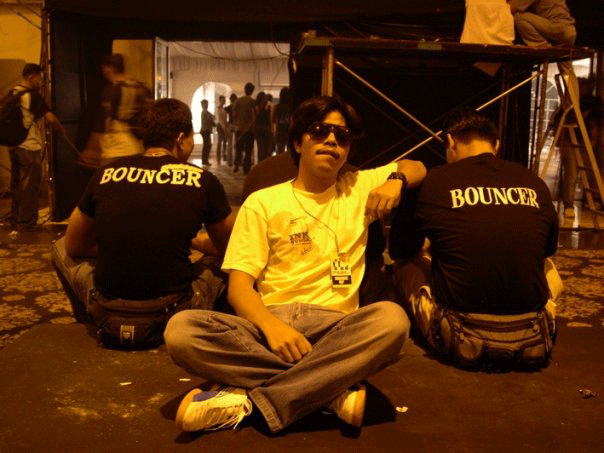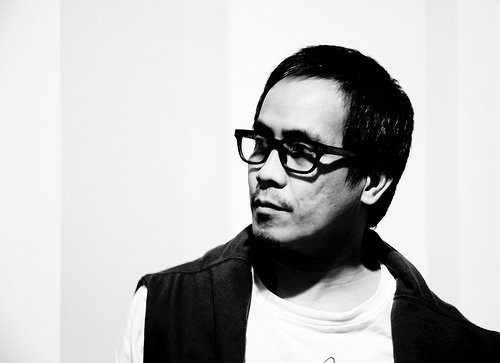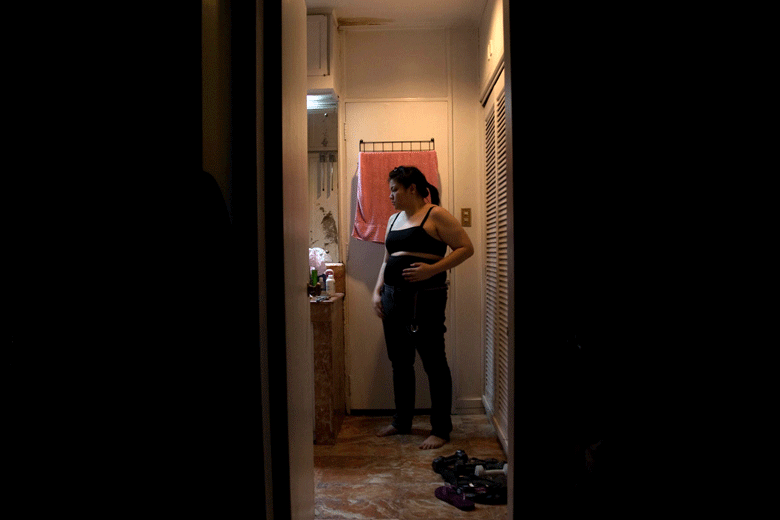
Tammy David is a 27-year old photographer. Her series of self-portraits called It Takes An Island is currently on display at the Silverlens Gallery in Pasong Tamo Extension along with two other shows, also documentary works, by Jake Versoza and Veejay Villafranca. TheSwankStyle interviewed Tammy David recently, albeit only via Facebook, on the occassion of this, her fourth group show, and her first for Silverlens.
You photographed yourself. Why?
I joined a portraiture workshop last September under German photographer Espen Eichhöfer. My original class project was to produce serial portraits of people experiencing quarter life crisis. That didn't work out so I had to resort to my back up which was self-portraits. I had to do it cause I didn't want to fail. Surprisingly, this is the project which got the most positive feedback. Personally, it turned out to be a terrific learning experience since, as what a young American photographer said, 'How can he take intimate photographs of other people when he can't do the same to himself?' I can now understand my subjects more.
This is like telling the world you have a weight issue, which isn't something a lot of people would do.
I have always been vocal about my weight issues from writing about it in the paper to tweeting about my 6-course merienda. In the past I have been invited to model in magazines as a person of size but refused because I know the impact is different when it's visual. So when the time came to do my self-portraits, I had to remind myself I had to produce a damn good job. My goal was to please myself as a photographer and not attract a potential husband or a talent scout. Self-portraits are supposed to reveal things about the subject and with me, it includes late night eating in a parking lot and wearing spanx. I was consoled by the fact I only have to show it to the instructor and eight other students. I just didn't expect Silverlens to give me the opportunity to make it into a show six months later. Even during the opening reception I got myself a bit drunk since it still felt uncomfortable seeing people look at photos of me in my bathrobe. But it felt good seeing people laugh at my photographs instead of feeling sorry for me or worse, look away.
What camera did you use for the works in the show?
I used a Canon EOS 30D with a Sigma 17-70 lens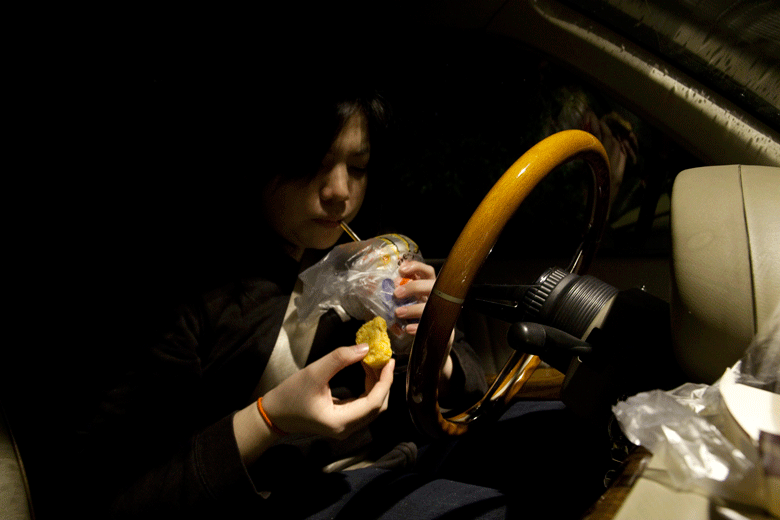
Can you describe to me the physical work involved in setting up these photographs? Were they shot at home, etc, was there anyone else in the room?
They were shot at home, office, my gym's locker room and inside the car. All photographs were taken with the self-timer function. There came a point I got used to taking pictures that I would even leave my gear in my car trunk just in case. One of the best compliments I got was from my cousin who refused to believe I took the photographs when in reality, I was alone the whole time. It means I am a pretty good actress or despite the set up, it feels authentic.
What drew you to photography?
My dad is a hobbyist and would pass on his old cameras to me. When I was 16, I was writing for the youth section of a national broadsheet then and I got paid more with photos compared to text. For a teenager, extra cash was always good. Around the same time I was exploring journalism, I was moved by the works of photojournalists Romeo Gacad, James Nachtwey, Dan Eldon and the Magnum photographers. I realized I was able to express more through photographs and used photography as an introspective tool so I stopped writing and focused more on photography.
Who are your influences?
When people look at my work, they feel I am heavily influenced by Western photographers which I can't really deny. It's the Western photographers who flooded National Geographic, Time, World Press Photo awards, Phaidon books plus had a strong presence in the Internet. I have a couple of influences who I am blessed to consider as mentors as well. Renowned Filipino photojournalist Romeo Gacad of Agence France Presse (AFP) is one. I was only seven when I came across the book 'Bayan Ko' and it made me want to be on the frontline of history as well. Another is Jose Enrique Soriano who in my opinion is one of the best documentary photographers ever. The depth of his work on mental patients affected and inspired me to do more stories instead of the single image. Lastly another big influence in my life as a photographer is Peter Bialobrzeski. Taking his workshop in January 2008 at Silverlens taught me professionalism and to be more open to other work. I'm self-studying now on German Photography and I'm excited to get a copy of Dusseldorf School.
Are there particular subjects that are most attractive to you?
I like to do documentaries that are offbeat which is not a lot of blood or poverty. I credit my curiosity to two of my personal projects namely Beauty Queen Boot Camp and Fat Acceptance in America. Most of my work is about women because I obviously have an advantage in terms of access and a lot of people want to know more about women! I also like stories that are very positive that will leave the audience with a smile instead of a heavy feeling in their chest.
Tammy, Jake and Veejay give a free talk today at 3pm at Silverlens on documentary photography.
Saturday, February 27, 2010
IT TAKES AN ISLAND ] Tammy David trains the camera on herself
Monday, February 22, 2010
GANGLAND ] Veejay Villafranca shoots the gangs of Baseco
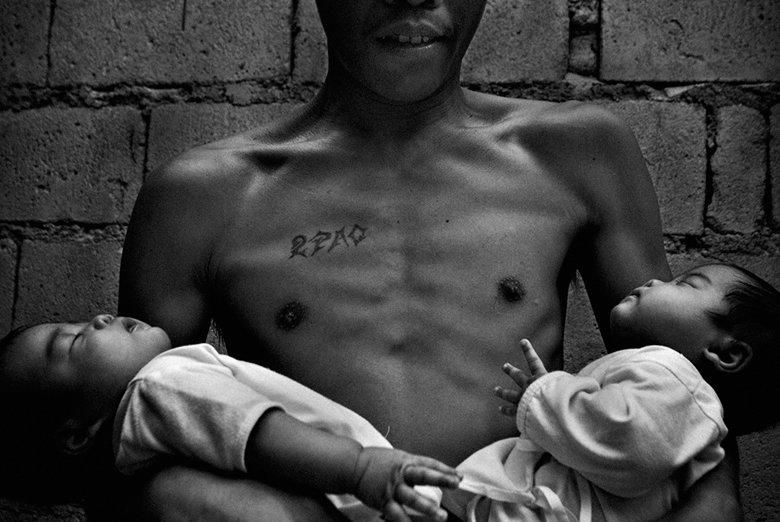
In 2007, photographer Veejay Villafranca began toiling on Marked: The Gangs of Baseco as part of his final portfolio in his photojournalism class at the Asian Center for Journalism of the Ateneo. It took him two years before he could finally wrap up work. “During the first year and a half of the project, I would be there almost every day,” he says. “It also came to a point where I was already looking for a small space in the compound. Then the succeeding year I would make it a point to visit at least twice a month.”
Baseco is, of course, not the swankiest of places to live in. Situated in Port Area, Manila, it is made up of 52 hectares of reclaimed land and there are more than 47,000 families living in shanties standing on stilts rooted on swampy grounds. Occasionally, the polluted waters of Manila Bay would even find its way to these ramshackle homes. “It was purportedly built as a world class resort by former First Lady Imelda Marcos,” says Veejay, “but turned out to be the town where dreams of greener pastures have perished.” Baseco actually stands for Bataan Shipping and Engineering Company.
While the entire former shipyard was certainly overwhelmingly throbbing with various unsettling subjects, the young lensman zeroed in on the gangs, particularly the Chinese Mafia Crew.
“You know one person recently made a comment about my photos,” Veejay tells Swank. “She said she works daw as a nurse in the compound and she was asking, inspite of my 'brave' efforts to document the gangs, why not tell the story of everything 'good' that was happening and that has happened in the area. I said, ‘You see when I met these people, they were hostile. They didn’t want to talk and they were very apprehensive to be photographed. When the time came that they opened up na and accepted my intrusion, I was greatly humbled and thankful. As I continuously documented their lives, I grew as well. From the dangerous nature, tattoos and drugs, I saw that they are young hopefuls longing to get out of the vicious cycle. I have learned that one by one they have been disappearing from the slums because most of them are already working. This was the same reason I documented this story. Another story of poverty and struggle, but a new story of hope and change.”
Just recently, Veejay found himself back in Baseco, although for an assignment not related to the gangs. “I dropped by in one of the gang members’ houses. The mother was there, but the guy wasn’t. She said he was working and would only go home during weekends. That made me smile.”JG
In 2008, Marked: The Gangs of Baseco won for Veejay the Ian Parry Grant. Ian Parry was a young photographer who died in a plane crash in Romania. As a tribute, his friends and editors set up this award in London for young emerging photographers every year. Marked is part of the ongoing three-man photography show (with Jake Versoza and Tammy David) called STRIP 2010 at the Silverlens Gallery in Pasong Tamo Extension.
Images courtesy of Silverlens. For more of Marked and Veejay's works, click here.
Thursday, December 24, 2009
CD PAINTS, JUAN SHOOTS ] The FINAL last art post for the year
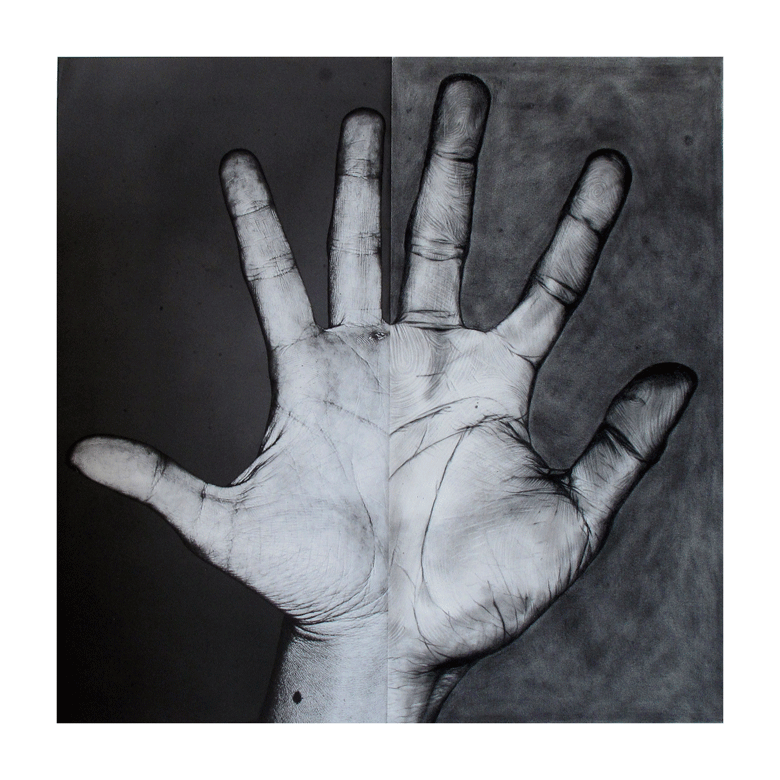
I know I said two posts ago that that was my last art post for the year. But how can I refuse this? Talk about art imitating, well, ME. Kidding. Painter Christina Dy and photographer Juan Caguicla stir the idea of the diptych a little in their January 2010 show at Silverlens (opens on the 13th). "The STEREO I series is a collaboration between me and photographer Juan Caguicla," says CD (she's the one artist who gets away with being called by her initials). "He photographed me (so that's my hand there on the left side) and I drew him (that's his hand on the right), and we put our works together to make up two sides of an altogether new thing." Guess which is whose.
Sunday, December 13, 2009
CARAMOAN X 6 ] Just imagine an Andok's by the beachfront

Jun de Leon captures the early morning of Caramoan Island, inspired and reminiscent of a Juvenal Sanso. “Photographs capture a precise moment in a still image. How you take the subject the second you click on your shutter will not be the same the second after. There are numerous moments to be captured in such a breathtaking island.” As long as they preserve its beauty, and not turn it into Boracay, we're all for promoting Caramoan as the next big destination. Jun de Leon, together with Camsur poster boy L-Ray Villafuerte, recently gathered five of the country's most prominent young photographers to capture their own visions of this prized island. The works will be on exhibit beginning this Thursday at Greenbelt 5. Left photo (from left): Jake Versoza, Paolo Pineda, Jo Ann Bitagcol, Jun de Leon, Sara Black and Mark Nicdao.
As long as they preserve its beauty, and not turn it into Boracay, we're all for promoting Caramoan as the next big destination. Jun de Leon, together with Camsur poster boy L-Ray Villafuerte, recently gathered five of the country's most prominent young photographers to capture their own visions of this prized island. The works will be on exhibit beginning this Thursday at Greenbelt 5. Left photo (from left): Jake Versoza, Paolo Pineda, Jo Ann Bitagcol, Jun de Leon, Sara Black and Mark Nicdao.
Jake Versoza uses blacks, grays, and whites in his docu-photo treatment. “I wanted to document the daily lives of the people there because they thrive off nature’s bounty both in land and sea.” How do you capture warmth on film? He answers,” I was there during a strong typhoon but found peace hanging out with the locals. That’s warmth.”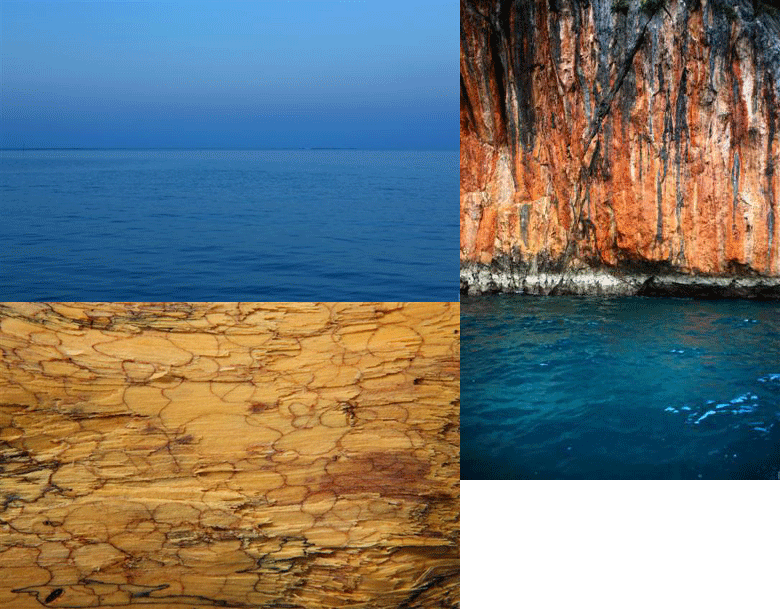 “As a photographer, whenever I go to a place, I always observe how the light there falls and how that affects the color of everything," says Sara Black. Caramoan has its own color palette and I enjoyed tremendously photographing that in its simplicity… the color in the little things. For me, it’s such a sincere joy to appreciate something as miraculous as color.”
“As a photographer, whenever I go to a place, I always observe how the light there falls and how that affects the color of everything," says Sara Black. Caramoan has its own color palette and I enjoyed tremendously photographing that in its simplicity… the color in the little things. For me, it’s such a sincere joy to appreciate something as miraculous as color.”
“It’s the emotion and feeling of the place. It’s a rollercoaster ride. Caramoan has the balance of things you need when you’re on vacation mode. It has a bit of everything you want.” A natural portraitist, Mark Nicdao captures smiles, gleeful eyes, and innocence in his photographs. Jo Ann Bitagcol, on the other hand, captures everyday scenes in the island. “Everywhere I go I make it a point to discover its beauty, life, and soul. And I saw all of this in Caramoan,” she says.
Jo Ann Bitagcol, on the other hand, captures everyday scenes in the island. “Everywhere I go I make it a point to discover its beauty, life, and soul. And I saw all of this in Caramoan,” she says.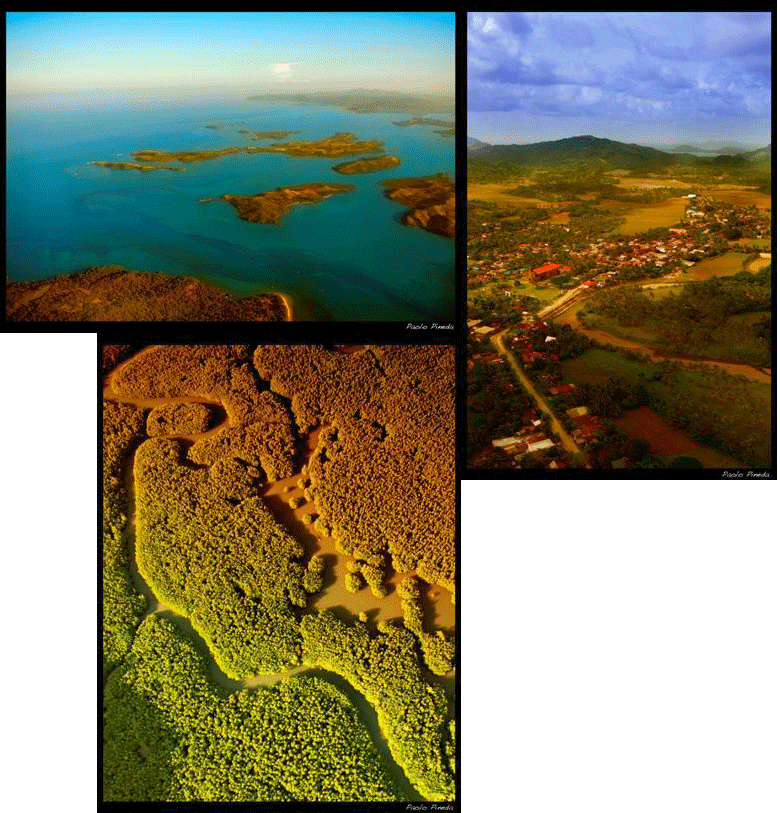 “We rode the chopper going to Caramoan from CamSur," says Paolo Pineda, and seeing it from that vantage point was just surreal. I wanted to capture the island like a classic painting… timeless.”
“We rode the chopper going to Caramoan from CamSur," says Paolo Pineda, and seeing it from that vantage point was just surreal. I wanted to capture the island like a classic painting… timeless.”
Thursday, December 10, 2009
MASK MASAYA 'TO! ] A call for portfolios to a photography workshop on portraits and identity

The Apprentice and her Master, 2008
Marc Lathuillière, the French lensman behind “France Face Lost,” will hold a free workshop from 10am to 3pm at Silverlens Gallery on January 30 and February 6 sponsored by Alliance Francaise, followed by an artist’s talk at Silverlens on February 6 at 6pm to introduce his work and artistic approach.
Dealing with French identity and observing France after an extended stay in Asia, Lathuillière questions the stereotypes on which we build our identities with his use of masks. From Provence to Normandy, and from Bordeaux to Metz, more than four hundred people have already let him take their “de-faced” portraits.
The Quality Meat, 2008
THE WORKSHOP
Day 1, 10am-3pm (5 hrs): From Psychological to Masked Portrait
Participants are invited to bring national costumes (Maria Clara, terno, barong, malong, etc.) and examples of their photographic works, either printed or on a USB flash drive. This session will be spent mostly in the studio.
Day 2, 10am-3pm (5 hrs): From masked to contextual portrait
This second session will be spent mostly outdoors. Participants are invited to bring their own mask. It would be helpful if those who have their own laptops could bring them to the session.
Feb 06, Saturday, 6pm: Artist Talk
“How is it possible to take pictures of the other, whether as a local or a foreigner? What can photography tell us about identity construction? Here are the questions I intend to raise with this Unmasking.”- Marc Lathuillière
The Provence Winegrower, 2008
APPLICATION PROCESS
Participants to the workshop must first apply for a slot by submitting a portfolio of their works in PDF form along with a CV to Leonore Casuga at manage@silverlensphoto.com. Applicants may also send a cd to Silverlens Gallery, 2nd Floor YMC Building, 2320 Pasong Tamo Extension, Makati City, 1231. Applicants may include their website address in their CV as a supplement, but still need to submit a portfolio in PDF form.
The portfolio should be submitted by December 31. The list of accepted participants will be announced on January 16, 2010.
Marc Lathuillière’s exhibition of photographs “France Face Lost” opens at the Alliance Française Total Gallery on Tuesday, February 2, 2010, with cocktails at 6:30 pm. It will be on exhibit until February 25, 2010.
For inquiries, contact Silverlens Gallery at 2/F YMC Bldg. II, 2320 Pasong Tamo Ext., Makati, 816-0044, 0917-5874011, or manage@silverlensphoto.com. Gallery hours are Monday to Friday 10am–7pm and Saturdays 1–6pm. www.silverlensphoto.com / slab.silverlensphoto.com.
All photographs by Marc Lathuilliere, courtesy of Silverlens Gallery.
Thursday, December 3, 2009
SING SHOTS ] Silverlens hosts Singapore photo festival in Manila

On December 11 to January 9, select works from the Singapore International Photography Festival (SIPF) 2008 will travel to Manila for a month long exhibition.
SIPF satellite partner, Silverlens Gallery, hosts the visual feast for the Filipino community, providing extended exposure for the select SIPF 2008 photographers.
The SIPF is a biennial gathering of minds from around the world with the common pursuit of advancing the art and appreciation of photography. The 2008 SIPF hosted juried exhibitions, workshops, and portfolio reviews. Isa Lorenzo, Silverlens Creative Director was one of the panelists of SIPF 2008, participating in the portfolio critiques, as well as giving a talk on Collecting Photography. 
“This exhibition at Silverlens is a selection of work from the juried shows. We are happy to be part of this network that shows interesting and powerful photography”, Lorenzo says. On a broader scale, SIPF presents a key platform to discover, nurture and propel Southeast Asian photographers onto the international stage.
“Among the many objects that surround us, a small photograph could be the most amazing object. It carries you away, it touches you, teleporting you in time, through memory and imagination,” says Terence Yeung, Curator of SIPF 2008. 
The SIPF exhibition at Silverlens Gallery opens on Friday, December 11, and runs until Saturday, January 9. For more information and inquiries, please contact 816-0044_, manage@silverlensphoto.com or visit the gallery’s website at www.silverlensphoto.com / www.silverlensphoto.com/slab.
All photographs by Vee Speers from The Birthday Series. Courtesy of Silverlens Gallery.
Monday, November 16, 2009
PHOTO 'RELEASE' ] Isa Lorenzo blows off steam, Rachel Rillo brings it down to size
 Empress, and Infinity, both Isa Lorenzo, 2009
Empress, and Infinity, both Isa Lorenzo, 2009
Tomorrow, two photography shows open at the Silverlens art spaces: Isa Lorenzo's Release at 20square and Rachel Rillo's Grain at Silverlens.
Largely a physical reaction to her time as a recipient of the Japan Foundation Jenesys Program Creator-in-Residence at Tokyo Wonder Site, Release explores the underside of the Japanese cultural identity – one that prioritizes homogeneity and conformity - and probes human expressions for “letting one’s hair down,” and “blowing off steam.”
Using the Philippines as her reference point, the artist observed that the assimilated group identity in Japan supersedes the individual’s identity. They have a saying: the nail that sticks out is hammered hardest. As a reaction to societal homogeneity, their “expressions for releasing control are extreme in Japan through subcultures—fetish, cosplay, and wota. As the title suggests, my work for this show takes off from this premise of releasing control,” says Lorenzo. Eternal Return, Isa Lorenzo, 2009
Eternal Return, Isa Lorenzo, 2009
The photograms in Release are from printed material ubiquitous to public spaces: tear sheets, exhibition flyers, performance advertising. They are layered aesthetically and printed correctly with the corresponding tonalities. Half of the pieces in Release, she leaves unaltered. They remain controlled. The other half, she disrupts the perfect layering and printing by using micro explosives - a release control from the darkroom.
Followers of Lorenzo’s work will notice that each piece is titled with a word or two – a marked departure from her pattern of leaving works numbered or dated. Lorenzo says, “the series is a set of traditional and universal symbols but are also personal talismans to move ahead in life”. Release is a collective set of accidents and mistakes, of images disrupted, of spontaneous signifiers.
This show is made possible with support from the Japan Foundation, Manila. Buddha, and Ganesh, both photographs Rachel Rillo.
Buddha, and Ganesh, both photographs Rachel Rillo.
Rachel Rillo's latest work is a meditation on paring things down to their material source: plaster, wood, plastic. Objects photographed are small figures that are visual representations of something real. With the use of light alone, Rillo intentionally alters and deletes backgrounds and other contextual hints. Size, the environment and any other relationship the object photographed could have outside of the material from which it is made and what it symbolizes has been negated.
“Photographically, this particular work was a challenge because I had to get rid of all clues surrounding the object. The task was to make the photographs as minimal as I could get them to be without touching them up but altering them with only light,” says Rillo. House 1, House 2, House 4, all Rachel Rillo.
House 1, House 2, House 4, all Rachel Rillo.
Grain is a glimpse into the quiet truths in the most basic of equations. A cube with a triangular top is instantly a symbol of a house. A rounded figure on a shaft is a bust symbolizing a human form.
There are installations of photographs of religious iconography paired with a small plastic bag of ground, melted, pulverized, and pulped material. Assuming that the bag holds part of the subject, the photographer posts the questions: Has the idol, icon, or symbol lost its meaning? Is it sacrilege? Is it a gram of dirt or a holy gram?
Grain is a meditation on the elusive gestures of form and material - the nuanced expression, the violent confrontation, the abandoned and scarred. It is a reflection of the disjunctive spaces between symbolism and spirituality, memory and possession.
Release by Isa Lorenzo opens at 6 pm in 20Square, Slab Gallery, and Rillo's Grain opens at Silverlens tomorrow, November 18, Wednesday and runs until December 12, 2009.
Monday, November 9, 2009
RYAN+GAROVS ] They shoot everywhere, don't they?
 Ryan shoots Ryan.
Ryan shoots Ryan.
You and Garovs, are you a couple?
Ryan: Yes! :)
Garovs: Yes, a couple of dorks.
What is everywhereweshoot?
R: It's an online portfolio
G: …that we put up after graduating from college to cut on printing costs when we’d apply for jobs. It used to be filled with projects we did through college and some cheesy portfolio material we’re not too proud of. Haha. Now its filled with published works and because you asked that question, I think its time to change our site’s layout!
How do you divide the work between you two?
R: Garovs as the stylist and creative director who assists me when she doesn’t style or direct.
G: Ryan as the Photographer and web designer who is also my assistant stylist when we’re shooting and when we’re not. Both (of us) Graphic Designer and driver.
How long have you been working together?
R: Since late 2005.
How's it been so far?
R: Lovely! hihihihi
G: Four years went by too fast!
What do you admire most about his work? About hers?
R: Everything.
G: Spontaneity and randomness. When we need to brainstorm for a project, we realized that when we’d meet to list down ideas, we’d end up arguing and wanting to kill each other. So now we’d do errands, walk around malls or parks, visit friends, make chikahan, eat, then somehow, at the same time, we see something that links to the project—KA-BOOM! We get excited and build on it. Concept done. Eerie, no? Or maybe we’re just making up excuses for not wanting to work on a desk at office hours.
 Garovs by Ryan.
Garovs by Ryan.
What inspires you?
R: Everyday life.
G: Coffee and cigarettes after lunch.
How do you start your day?
R: Checking our email.
G: Go through my bookmarks, while facebooking, ‘til coffee kicks in.
What do you look forward to on an ordinary day?
R: Doing unusual stuff
G: Getting a haircut, going to the park. Also, randomly seeing a friend and making chikahan
What's the best thing about what you do?
R: Being able to do what we love to do everyday and seeing we can do it forever.
G: That we get to meet interesting people in the photo/ fashion/ graphic design/arts/music/film and other industries that we work with.
Describe your work station/desk/studio? Favorite things that it contain.
R: It's a mess.
G: We work outdoors, usually in the car too, we don’t take too long rendering things on the MBP. I think The Fort is our workstation. Highstreet has a steady breeze, grass, chill passersby, and treats! And friends!
Music you agree on most of the time.
R: Old music, indiepop, any song actually
G: Ryan, aminin mo na, we love belting out on 96.3Wrock!
What are you working on at the moment?
R: Secret.
G: Yes, will launch the secret by December. Its not Victoria’s ha! Also, we’re working on sleeping before 3am.
For the works of everywhereweshoot, click here.
Saturday, October 3, 2009
EYE ON THE STORM ] Parma from the windows of Mark Nicdao



Photographs by Mark Nicdao.
Thursday, October 1, 2009
THE NEIGHBORHOOD ] Art don't live there anymore
Like most provocative art, this one has an ample ingredient of irony. While there have been galleries established before it, the turning point happened when one opened inside the compound of a huge broadcast network, the network that gave birth to Pera O Bayong and Wowowee. In 2002, the artist Rock Drilon and his wife, the broadcast journalist Ces, decided to put up a branch of their magazine store Magnet inside ABS-CBN, on the ground floor of the newly mounted Eugenio Lopez Jr. Communications Center. The couple expanded it in the following year to include their first public art space. It was hard to tell then during that inauguration party, with drunken artists and guests all of a sudden popping balloons on chairs and on the floor as if they were in some televised parlor game, that it will be the beginning of something big.
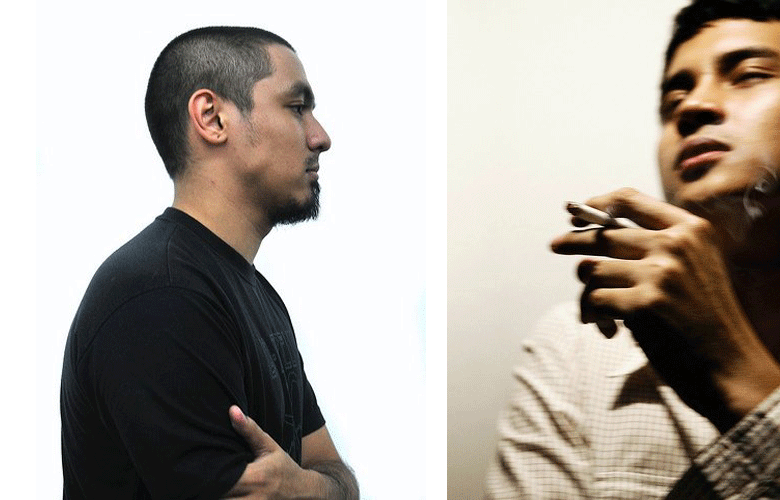 Cos Zicarelli and Pow Martinez
Cos Zicarelli and Pow Martinez
Lena Cobangbang
It was an outsider, Carlos Celdran, the famous Manila tour guide, a North Syquia resident so attached to the Malate bohemian scene, who pointed it out only recently, more than five years after Magnet Gallery opened: the center for arts and culture has moved out of Manila; it is now in Quezon City. Carlos had casually dropped by QC, and in one night had hopped from an art show in Cubao Expo to a contemporary dance performance at Green Papaya Art Projects in Kamuning. He raved about its vibrance, its energy, its daring.
Before Magnet opened in ABS-CBN, of course, others have begun the handiwork for this blossoming of QC as center for a contemporary creative explosion. Big Sky Mind off E. Rodriguez has been hosting shows and performances for some time, and so has Green Papaya. But one could not deny the fact that it was the Magnet couple’s power reputation and network of artists and society people that got others looking at Quezon City as a destination to see art. Drilon would not lay claim to being the culprit, however. “The decision to open the galleries here was very personal,” he says. “We opened in ABS-CBN because Ces works there, and we opened Katipunan because it’s just across Ateneo where the kids study and I want to be near where they spend most of their time.”

Poklong Anading
“Nagkataon lang siguro na most of the seminal spaces which were artist-run, and which made significant contribution and impact sa practice ng mga artists ngayon, were located in QC,” says Norberto “Peewee” Roldan, the artist who runs Green Papaya together with his partner, the dancer Donna Miranda. Peewee is referring to the spaces that made their name in the early part of the 2000s: Big Sky Mind which used to be run by Katya Guerrero, daughter of the legendary Helena; Third Space; Junkshop; Future Prospects which was one of the first galleries in Cubao Expo; Magnet; and Surrounded by Water, the space named after the group of artists that include then upcoming Geraldine Javier, Wyre Tuazon, Mariano Ching et al. This last one was originally at 18th Avenue in Cubao before it transferred to that spot beside DOLE in Edsa, closing shortly after Edsa Dos. Today, only Magnet in Katipunan, West Gallery in West Avenue and Green Papaya in its new Kamuning space, are still standing.

Louie Cordero
 Nona Garcia, Lyle Sacris and Romeo Lee
Nona Garcia, Lyle Sacris and Romeo LeeIf indeed QC has become the country’s art center, Peewee explains the Manila-QC art scene transition this way:“Una, with regards to the impression that Malate used to be where the arts and culture scene is, I think the basis for this is the location of the CCP, di ba? And if this is true, we are talking here of the particular period when CCP was still the hotbed for contemporary (conceptual) art exhibitions/happenings. And this should be sometime from the early 70s (the era identified with Bobby Chabet and Rey Albano) to the early 80's. We should also remember that during this time, the Museum of Philippine Art, then presided by its eminent director Arturo Luz, was where the young emerging artists (Santiago Bose, Gus Albor, Lao Lian Ben, etc.) of the local art scene where being shown. While at the nearby Metropolitan Museum of Manila (MET), works by big international names like Joseph Beuys, Frank Stella and Andy Warhol had been mounted. It also helped that Malate, particularly the Penguin Café, was where the bohemian community congregated during this time.
“Although I consider myself actively involved with the early Nationalist movement, having been a cultural activist/organizer in Negros Occidental during the ‘80s, I must admit that the CCP lost its grip on cultural hegemony when it adapted the "nationalist" policies and agenda that were brought in by the new power structure after the People Power revolution. My point is, if there is a shift of the art scene, from Malate to QC, hindi siya nangyari overnight. My contention is, hindi na art destination ang Malate even during the ‘90s.”
Peewee adds that it is difficult to support the claim that the art and culture scene has already moved to QC. “Siempre palagi namin sinasabi: ‘QC rocks!’ But it's more a battle cry--sloganeering, if you may--than a legitimate claim. What is rather easily recognizable is there are more venues in QC, not necessarily art galleries, that have become hangouts for visual artists, independent film makers, writers/poets, critics/academics/scholars, who constitute an important segment of our local art institution/infrastructure.”
These venues have undoubtedly helped nurture the community and the people that make it thrive and flourish. For the common art enthusiast, one can make a day just seeing art and being surrounded by artists when one is in QC. One can begin by visiting the sculptures at the UP Fine Arts compound in Diliman, or come to Magnet in the afternoon where there is a daily screening of some of the most groundbreaking works being made by a new generation of filmmakers. Of course, there’s the ongoing exhibit by an important artist. Or the works hanging on the walls at the cafe upstairs. Every second Monday, the poet Joel Toledo, who teaches literature across (Miriam College) and lives a tricycle-ride away, hosts poetry nights.
There are three other important galleries to visit: Green Papaya, West Gallery, and Boston Gallery, one of the more senior art spaces here, located in Cubao, established for the group of young artists in the early ‘90s called Salingpusa by the doctor and art patron Joven Cuanang. Towards the evening, one can start driving over to Cubao Shoe Expo near Ali Mall and the bus station. Not a few times called The New Malate, it is an enclave of curio shops and galleries (there are at least four in existence at the moment) but its center is the open air resto-bar-cinema Mogwai run by film artists Erik Matti and Lyle Sacris. Mogwai, since it opened late last year, has become the after-opening hangout. Whether the evening’s show opened in Makati or Megamall, the artists and their friends often congregate here in its welcoming open space, its generous Gerry Araos table, and the devil-may-care vibe.

Jeremy and Gary Ross Pastrana
It is this laidback feel that permeates in the city which, really, is more like a neighbourhood where rent is cheap, beer is cheap, there is an ample blessing of green everywhere, and where your friends live near. QC is filled with little known bookstores, shops, eateries, surprises in its quiet little streets. “The relaxed atmosphere is so important in an artist’s life," says Drilon, "because it is usually the perfect surrounding that allows one to create.” While the academics and the intellectuals have lived around the university vicinity for years, some of today’s most sought-after artists also live and work in the area, from Drilon to Roldan to the younger hotshots: Poklong Anading, Louie Cordero, Lena Cobangbang and Jason Oliveria live in Cubao, Robert Langenegger in Maginhawa, Reg Yuson has just renovated an entire ‘50s house to build his modern home/studio in Panay. From the film community, there's John Torres in Sikatuna, Khavn dela Cruz in Kamias and, of course, the late Alexis Tioseco was a resident of Times Street. And then there's Lourd de Veyra off Anonas.
“I feel that there is always a shifting of the 'center' not because of some geographic/topographic tension, but owing to a very unstable, impermanent and almost nil support for the arts in this country.,” says Roldan. “Among the three most important support mechanisms, namely: government support reflected in policies/infrastructure that encourage and sustain artistic and cultural production; private patronage in the form of the commercial gallery system, corporate funding and sponsorship, institutional and private acquisitions, etc.; and, peer/community support, it's only the peer/community system that is consistently supporting artists. Therefore, if you look at the art scene from this perspective, it appears that the art scene in QC is more vibrant and dynamic than anywhere else because there is a concentration of peer communities here.” Jerome Gomez
Story originally appeared in Metro Society May 2009 except photographs.
Wednesday, September 23, 2009
NOW PUT ON A SCARF ] The inspirational book you don't have to read
 The girl on the cover is Julie, one of Schuman's favorite subjects. "She is very chic but she is far from perfect, physically at least. Julie has one leg slightly shorter than the other, has very slim arms and walks with a very slight limp. However, she has never let her physical challenges...diminish her presence."
The girl on the cover is Julie, one of Schuman's favorite subjects. "She is very chic but she is far from perfect, physically at least. Julie has one leg slightly shorter than the other, has very slim arms and walks with a very slight limp. However, she has never let her physical challenges...diminish her presence."
It’s not about fashion, but self-expression. People introducing themselves by way of clothing. By way of gestures, little nuances. As in a pocket square that, at closer inspection, reveals itself to be not just one square of fabric, but three layers—white and two shades of light blue—handstitched on top of the other, with three embroidered dots near the edge of a corner. It’s a woven friendship band on the ankle of a distinguished-looking man wearing a grey suit with abbreviated pants. A little flower pin on the peak of a suit jacket’s lapel. A fan. A hat. A glove. Or the utter simplicity of a white shirt and a navy skirt (put on a pair of pearls and you have the impeccable simplicity of Carolina Herrera). Forget the writing, it was never the author’s strength. He always sounded a little silly to me (this one obviously went through the eyes of an editor). The photographs are beautiful and inspiring. Nice to have during those days when there’s absolutely nothing to wear. It’s not about trends. It’s not Vogue. It’s more real and yet more uplifting. It’s about the man on the street being comfortable in his or her own fabulousness. Jerome Gomez
You can buy the book (a thousand bucks at National), or just click this.
Tuesday, August 25, 2009
LIGHTING IS EVERYTHING ] Frankie Callaghan's pretty view of ugly worlds
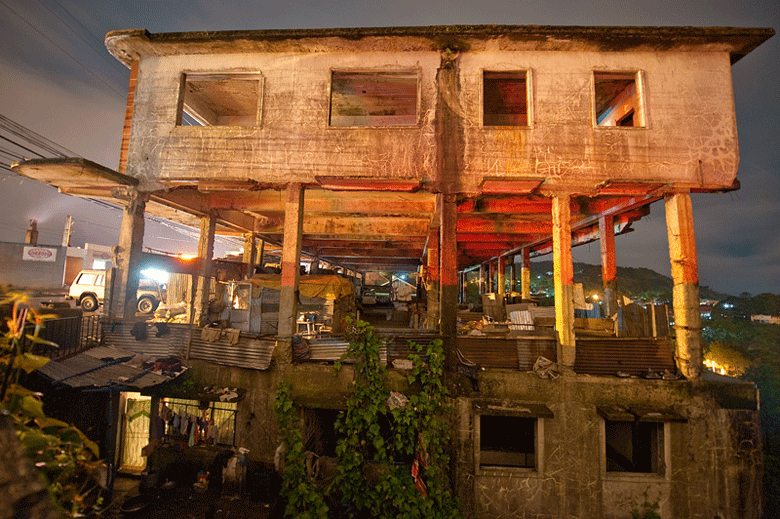
Silverlens proudly presents Dwelling, a series of images by Frankie Callaghan. As in his process and concept, Callaghan captures the ambient aura and light of the city. He takes to the backstreets and saturates dwelling places, monuments of cement and metal, in washes of light and color from their immediate surroundings. 
He seizes rare glimpses of stillness, steeped in an acute awareness of the present. “I found myself drawn to the quiet, empty spaces of urban fringes at night and to the unintentional beauty of dwellings that seem to have grown organically out of the sincere need for shelter and the limits of material and space,” says Callaghan. His forthright perception eliminates the noise of judgment and elucidating the scenery with evidence of stories and leaves viewer to speculate. And as a product of his candid process and perception, he reveals the indwelling life and beauty that are most often overlooked.
Dwelling by Frankie Callaghan opens at 6 pm on Septmeber 9, 2009, Wednesday, and runs until the 3rd of October 2009 at Silverlens Gallery. As a related gallery event, Frankie Callaghan will be hosting Sound Reaction a music and sound event where musicians and DJs interact with the photographs from the show. The even will take place on October 1, 2009, Thursday from 6-9pm at Silverlens Gallery.
Dwelling will be shown alongside Archetypes by Stanley Ruiz at 20Square, and a group show featuring 10 collage artists curated by Gary-Ross Pastrana at SLab.
Saturday, July 18, 2009
PROOF OF LIFE ] Nico Sepe is alive and well and shooting in Sri Lanka
 Mahout and his elephant, a lifetime relationship.2007.
Mahout and his elephant, a lifetime relationship.2007.
The canvas on which photographer Nico Sepe paints with light is the whole world. His recent works are vignettes of daily life in Sri Lanka where he has been based since 2007.
Sepe knows no boundaries when it comes to fulfilling his fulltime commitment to photography. He documents realities with piercing rawness as he has done since the late 70s in the Philippines.Last month, he continued this commitment in yet another photo exhibition: “Sri Lanka: Past Times in Times Present.” One of the oldest City in Sri Lanka. Site of the largest dagobas and water tanks dating back centuries ago. Its also a destination for buddhist pilgrimage.2008.
One of the oldest City in Sri Lanka. Site of the largest dagobas and water tanks dating back centuries ago. Its also a destination for buddhist pilgrimage.2008.
"This is really a continuation of my commitment to photography. It never stops...I’m still around, still shooting and continuing my dedication to inform thru pictures," he said.
While most of the world see Sri Lanka as nothing but a place caught in the conflict between the Tamil tigers and the government, Sepe offers what he has witnessed – that of Sri Lankans' ordinary, day-to-day struggle to survive.
Sepe’s black and white images captured the lives of people in different corners of this South Asian country including the Sri Lankan capital of Colombo, the ancient city of Anaradhapura in the northwest and the southwestern city of Moratuwa.
"I’ve never seen these angles before. It's different when it comes from a person who is not a Sri Lankan," he said. Galle Face promenade in Colombo. Famous among locals and tourist for enjoying the sea breeze of Indian Ocean.2007.
Galle Face promenade in Colombo. Famous among locals and tourist for enjoying the sea breeze of Indian Ocean.2007.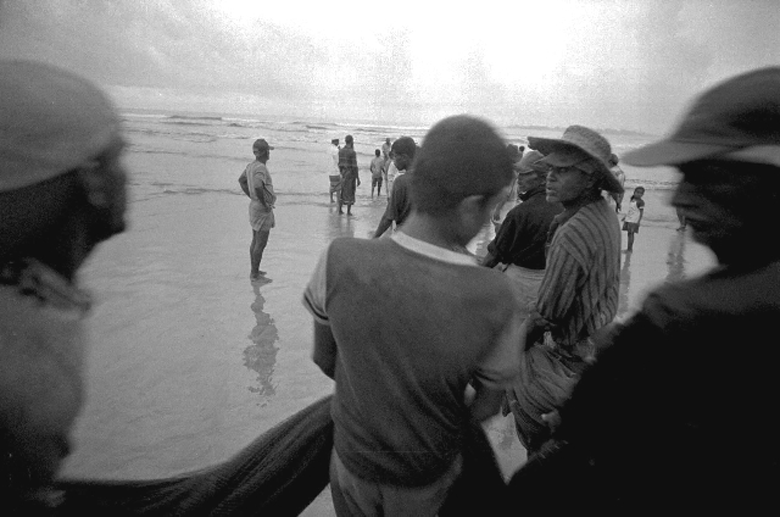 The fisherfolks of Galle, doing the traditional net pulling from the shore. Catch will be later distributed to everyone.2007.
The fisherfolks of Galle, doing the traditional net pulling from the shore. Catch will be later distributed to everyone.2007.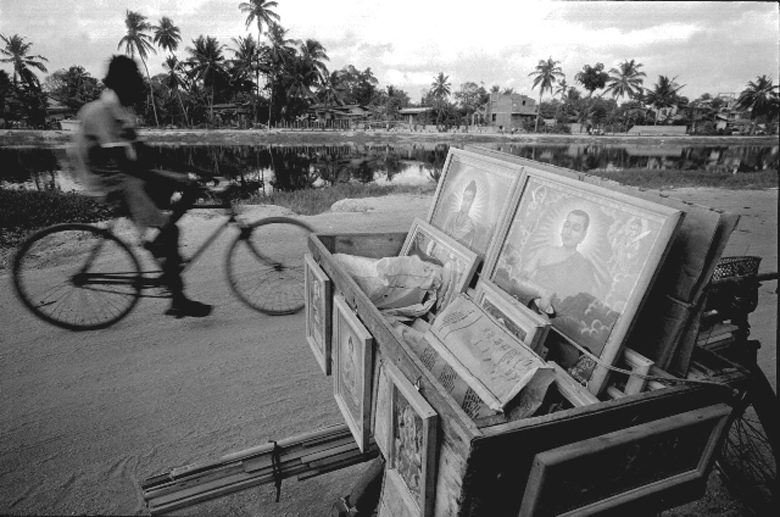 Pictures of Buddha for sale, decorating a typical Sri Lankan house especially on big Wesak Day celebration.2008.
Pictures of Buddha for sale, decorating a typical Sri Lankan house especially on big Wesak Day celebration.2008.
This is not the end of it. Sepe is planning to hold another exhibit soon. He doesn’t know for certain where his next stop would be but for now his home is Sri Lanka where he lives with his wife and two children.
Back here in the Philippines, he has documented the lives in the underground movement during the latter years of the Marcos dictatorship in the Philippines in the 1980s.
Since then Sepe has contributed significantly to documenting the social and political changes. Most assignments were commissioned by non-government organizations but his desire to photograph realities led him to fund some of the documentaries himself. Co-founder of the Center for Documentary Photography now known as the Philippine Center for Photojournalists and former senior staff of different newspapers and magazines in the Philippines, he has worked on various worthy book projects.
These include Philippines: A Journey through the Archipelago, the Philippine Navy's Tides of Change, the University of the Philippines' Sipat, the Ateneo de Manila University's Chinese-Filipino book and the coffeetable book Portraits of a Tangled Relationship.
His works have been widely recognized by fellow photographers and various global institutions. Tweety Andanar
Nico Sepe may be reached at nicosepe@yahoo.com. His online galleries are at www.katumbukan.blogspot.com and www.nicosepe.com. All photographs in this story courtesy of Nico Sepe who owns the copyright.



